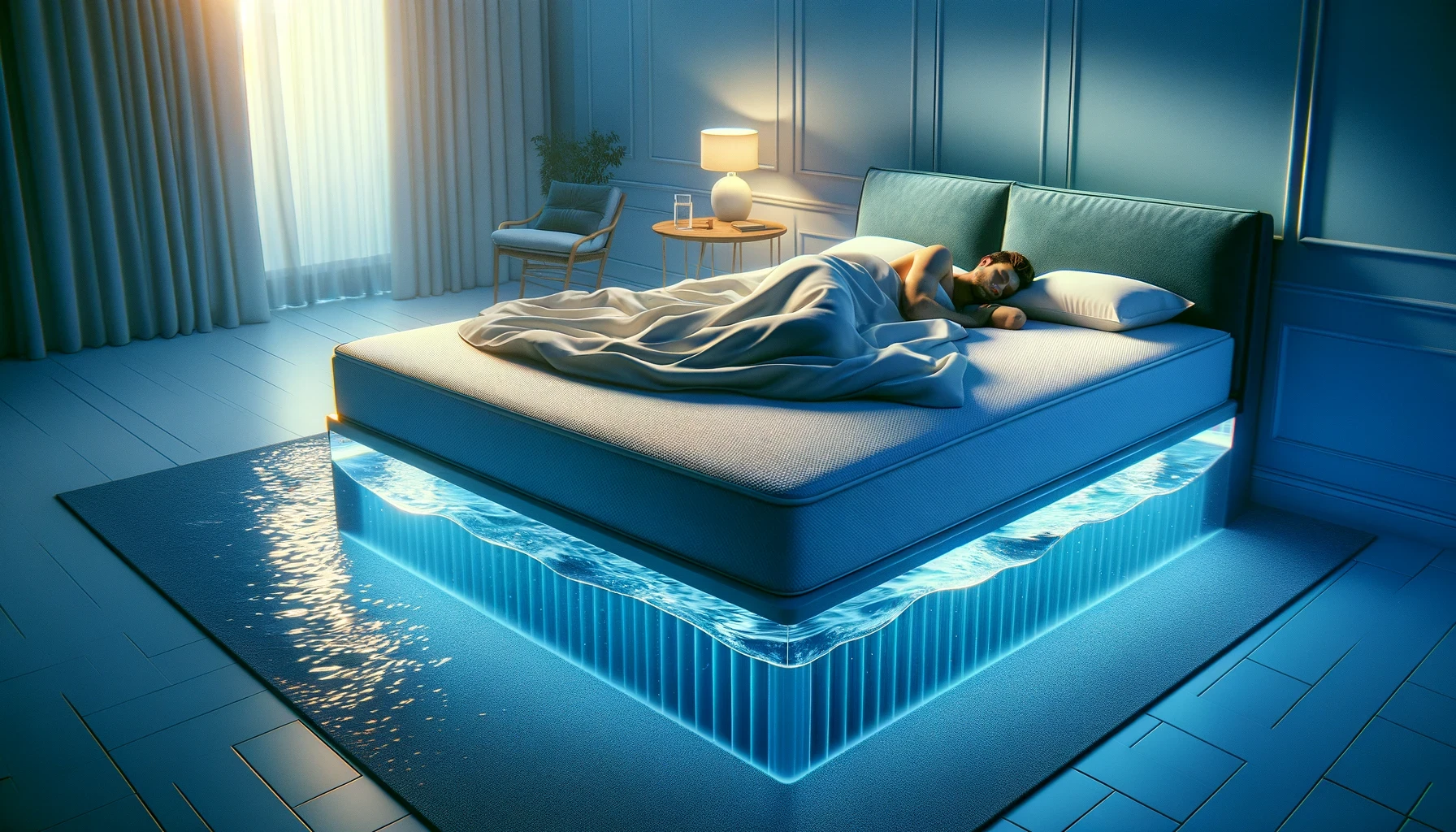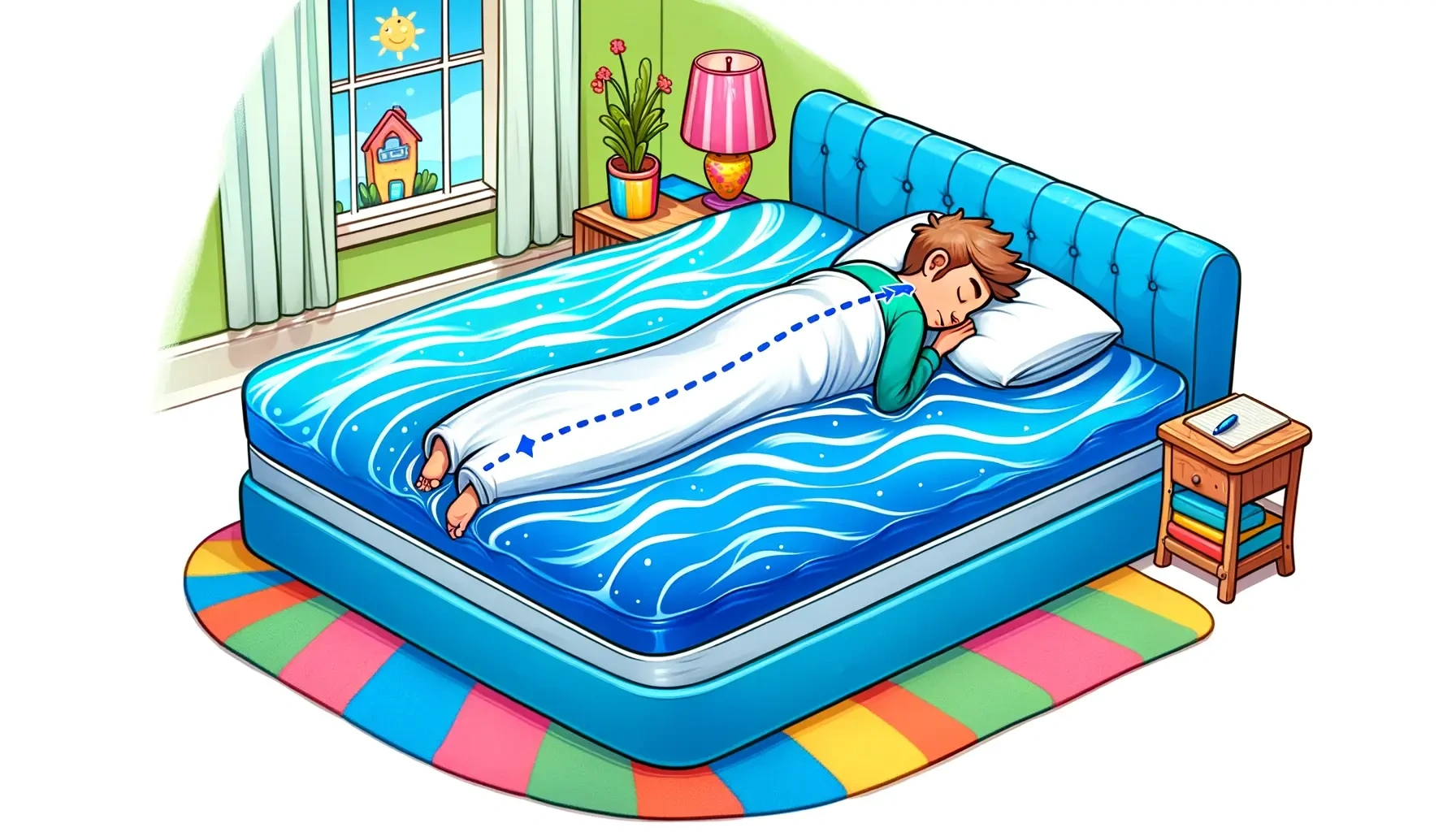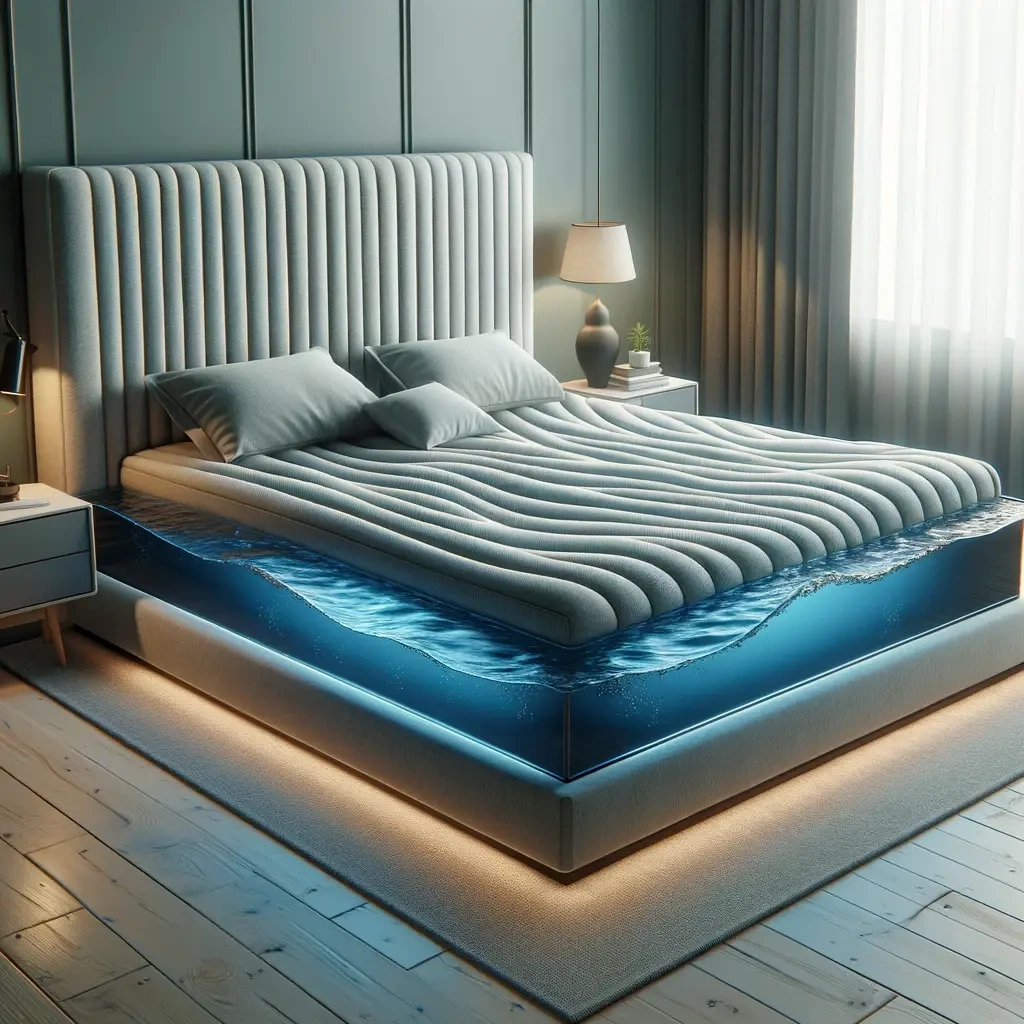Waterbeds were all the rage back in the 1970s, but then they kind of fell out of favor because people thought they were too much work to keep up with and move around.
However, today's waterbeds are easier to maintain and still offer many of the traditional benefits of a waterbed, so you can relax and enjoy the comfy, supportive sleep they offer.
Let’s explore everything you should know about waterbeds.
Key Takeaways
- Waterbeds offer conforming support, temperature regulation, and exceptional pressure relief, making them ideal for people with back pain or joint soreness.
- Maintaining and moving waterbeds can be stressful. The leakage and high sinkage level may not suit everyone, especially heavy sleepers or young children.
- High-quality waterbeds can last up to 15 years and are priced similarly to standard mattresses, though electricity costs for heating may add to expenses.
What is a waterbed?

Waterbeds are vinyl mattresses with a unique internal water filling, unlike most mattresses filled with foam, spring, or latex.
Waterbeds include water chambers, called bladders, which can be multiple small tubes or one large pocket, each offering a different level of support and wave sensation.
The majority of waterbeds also offer temperature regulation, letting you adjust the water to your ideal warmth for a comfortable sleep all year round, perfect for both hot and cold sleepers.
What is the Point of a Waterbed?
Waterbeds offer a unique sleep experience unlike any other, and their magic lies in their liquid core., which acts as a dynamic support system. This water adapts to your body shape and movement, providing even weight distribution and pressure relief. Waterbeds support your spine and back and reduces the pressure on your muscles and joints. This results in a restful night rest for many people.
What are the Types Of Waterbeds?
Hardside Waterbed
A hardside waterbed offers a unique sleep experience, cradled by a sturdy wooden frame filled with water. This design lets you feel closer to the water, offering a sense of weightlessness and deep relaxation. However, the integrated frame means this type of waterbed isn't compatible with other bed styles.
Softside Waterbed
Softside waterbeds are the most popular waterbed type because they feel and look like standard mattresses, as the water bladders are wrapped in foam layers, which could be made from latex, memory foam, or other materials.
The foam layer surrounding the water pockets not only makes the mattress feel like any traditional mattress but also makes it lighter and more durable than the hardside waterbeds.
What is the difference between waveless, semi-waveless, and free-flow waterbeds?
- Waveless waterbeds: Because it has extra layers that reduce water motion, a waveless mattress is more durable than a free-flow mattress.
- Semi-Waveless waterbeds: In comparison to a waveless mattress, a semi-waveless mattress has a few additional layers and promotes more water movement.
- Free-flow waterbeds: The purpose of a free-flow mattress is to work with a hard-side waterbed. It gives you the sensation of sleeping on the ocean and doesn't include any material to decrease the amount of waves.
What are the Benefits of Waterbeds?
Conforming support

Waterbeds offer a unique sleeping experience as they adapt and mold to your body shape and movements, and alleviate the constraint from the pressure points such as the hips, shoulders, and back, which makes it a perfect fit for anyone suffering from back pain or joint soreness.
Temperature Regulation
The ability to alter the temperature of the water is another advantage of waterbeds, as you can cool or heat the water to your liking to have a restful night's sleep. Warmth can help relax tight muscles, ease stress, and make it easier to fall asleep.
Durability
Only a few mattresses in the market can match the durability of high-quality waterbed mattresses as they can last for around 15 years with proper maintenance and care.
High-end waterbed mattresses can be a bit more expensive than regular waterbeds, but due to their long-lasting lifespan and exceptional sturdiness, you’ll get your money’s worth.
Low Cost
The price range for waterbeds is almost the same as regular beds, so you’ll be able to get all the features of waterbeds for the same price as traditional mattresses, however, before purchasing a waterbed you should also consider the electricity cost to heat the waterbed.
Why are Waterbeds Unpopular?
Excessive maintenance
Even though waterbeds tend to have a longer lifespan than regular mattresses, they need to be properly maintained and they require a lot of maintenance such as checking for leaks, refilling the water, and adjusting the heater, which could be annoying for some people.
Installation and moving
Because waterbed is filled with water, they tend to be pretty heavy, which makes moving them around very hard and challenging, especially, hardside waterbeds, as they’re even heavier because of the wooden bed frame.
Not suitable for everyone
The high level of sinkage that the waterbed offers can be vexing for some sleepers, as it could make moving around and getting in and out of bed harder, and some people might even feel stuck in the mattress.
Leakage
While waterbeds defy mold and mildew, they're not immune to leaks. Thankfully, leaks are rare and often caused by faulty valves, which are easily replaced. Regular inspections ensure you catch any potential issues before they disrupt your sleep.
Who Should Get a Waterbed?
- People who suffer from back pain: due to the waterbed's exceptional pressure-relieving properties, it’s a perfect choice for anyone suffering from back pain or joint soreness.
- Patients: waterbeds are encouraged by doctors from all around the world, and it’s often used in hospitals around the world, as they help relieve sore muscles, actively increase blood flow due to fewer pressure points, and it also beneficial in the case of bed sores.
- Hot or Cold Sleepers: Waterbed temperatures can be controlled, you can heat it if you’re cold and enjoy a relaxing sleeping experience, or you can cool it if you’re a hot sleeper and eliminate any chance of overheating during the night.
Who Should Avoid Waterbed?
- Children: Young children, especially infants shouldn’t be left unattended in a waterbed, as it could be hard for them to move in it.
- Heavy sleepers: heavy sleepers will not find waterbeds very comfortable as they require a firmer surface for them to be able to move and not feel stuck.
FAQ
Why Were Waterbeds Banned?
Waterbeds fell out of favor with the public because they are prone to leakage and a huge hassle to install or move around due to their weight.
Do Waterbeds Still Exist?
Yes, a few manufacturers still make waterbeds. However, it can be difficult to find one compared to how popular they were in the 90s.
How Much do Waterbeds Cost?
The cost of waterbeds vary based on quality, size and additional features. The price ranges from $50-$150 for low range options to almost $2,000 for higher end options.
Are waterbeds good for your back?
Waterbeds are great for people who suffer from back pain, as they conform to the shape of their body and alleviate the tension from pressure points such as the hips, shoulders, and back.
How long does a waterbed last?
Waterbeds are known to last longer than regular mattresses, however, the lifespan of a waterbed mattress can vary depending on the quality of materials, construction, and proper maintenance.
The average lifespan of waterbed mattresses is from 8 to 10 years, but it could last to 15 years with proper maintenance and regular inspection.
Do waterbeds get moldy?
When a waterbed mattress leaks, mold can occasionally start to form on the outside of the mattress. Although a little leak could go undiscovered for some time, the warmth and moisture provide the ideal conditions for mold growth. However, with proper care, this won’t be an issue.
Do waterbeds pop easily?
Waterbeds, unlike traditional mattresses, might leak, burst, or pop if their owners don’t take good care of them. Most owners of waterbeds must maintain their beds regularly to avoid this.
Do you put sheets on a waterbed?
Yes, you can put a sheet on a waterbed, however, keep in mind that waterbed sheets need to be larger, this is because a waterbed needs sheets that allow for more movement and space, because of the natural wave motion of a waterbed.
Conclusion
Waterbeds are beneficial for people with back pain and hospital patients, but they require a high level of maintenance from checking for leakage to refilling water.
Waterbeds can be very heavy to move around especially if it’s hardside, and if they are made from high-end material they could be a bit on the pricier side, however, it also offers exceptional pressure relief, it has temperature regulating features, and it’s one of the most durable mattresses in the market.
Jessica H.
Jessica is a reviewer, writer, and sleep enthusiast at Sleepiverse. Jessica graduated with her master's degree in Nursing research and education. She is a registered nurse and currently works in the Intensive Care Unit. Since becoming a nurse, Jessica has worked the night shift, which means a disrupted sleep schedule. Knowing she needed to function at her best while caring for patients at night, she spent a lot of time researching how to sleep well with a difficult schedule.


